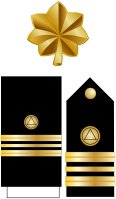Lieutenant commander (United States)
This article needs additional citations for verification. (January 2019) |


Lieutenant commander (LCDR or Lt. Cmdr.) is a Junior Officer rank in the United States Navy, the United States Coast Guard, the United States Public Health Service Commissioned Corps, and the National Oceanic and Atmospheric Administration Commissioned Officer Corps (NOAA Corps), with the pay grade of O-4 and NATO rank code OF-3. When introducing a lieutenant commander their full rank should always be used; however, in general conversation they are usually called "commander" even though they are not a "full" commander (which is one rank higher). Never use just "lieutenant" because it is one rank lower. The predecessors of the NOAA Corps, the United States Coast and Geodetic Survey Corps (1917–1965) and the Environmental Science Services Administration Corps (1965–1970), also used the lieutenant commander rank, and the rank is also used in the United States Maritime Service and the United States Naval Sea Cadet Corps. Lieutenant commanders rank above lieutenants and below commanders, and rank is equivalent to a major in the United States Army, United States Air Force, and United States Marine Corps.
Promotion to Lieutenant Commander in the U.S. Navy is governed by United States Department of Defense policies derived from the Defense Officer Personnel Management Act of 1980. DOPMA guidelines suggest 80% of Lieutenants should be promoted to Lieutenant Commander after serving a minimum of three years at their present rank and after attaining nine to eleven years of cumulative commissioned service.[citation needed]
While lieutenant commander is the U.S. Navy's first commissioned officer to be selected by a board, they are still considered to be junior officers due to their origin as "lieutenant, commanding".[1] This can be seen by lieutenant commanders not wearing the headgear embellishment (colloquially known as "scrambled eggs") on their combination covers. This is in contrast to other branches, where majors wear the appropriate covers of field-grade officers.[citation needed]
The United States Coast Guard used their own rank system until World War I. In 1916, discontent grew among Coast Guard captains:[2] By law, they ranked below a lieutenant commander in the United States Navy despite similar roles and duties. Pursuant to the Appropriations Act of 1918, the Coast Guard adopted the Navy rank structure to prevent disagreements over seniority.[3]
There are two insignia used by lieutenant commanders. On service khakis and all working uniforms, lieutenant commanders wear a gold oak leaf collar device, similar to the ones worn by majors in the USAF and Army, and identical to that worn by majors in the Marine Corps. In all dress uniforms, they wear sleeve braid or shoulder boards bearing a single gold quarter-inch stripe between two gold half-inch strips (nominal size). In the case of officers of the U.S. Navy, above or inboard of the stripes, they wear their specialty insignia, notably a star for officers of the line, crossed oak leaves for Civil Engineer Corps.[4]
- Insignia of lieutenant commanders in different uniformed services in the United States

United States Navy

United States Coast Guard

United States Public Health Service

National Oceanic and Atmospheric Administration
See also[]
- Military unit
- Comparative military ranks
- U.S. Navy officer rank insignia
References[]
- ^ "Lieutenant Commander". Retrieved 2021-03-15.
- ^ J. G. Ballinger to Commodore Bertholf. Letter Received 19 April 1916. USCG Records
- ^ Navy Circular 28762-115
- ^ "United States Department of Defense". www.defenselink.mil. Retrieved 28 March 2018.
| show |
|---|
| show |
|---|
- Military ranks of the United States Navy
- Military ranks of the United States Coast Guard




